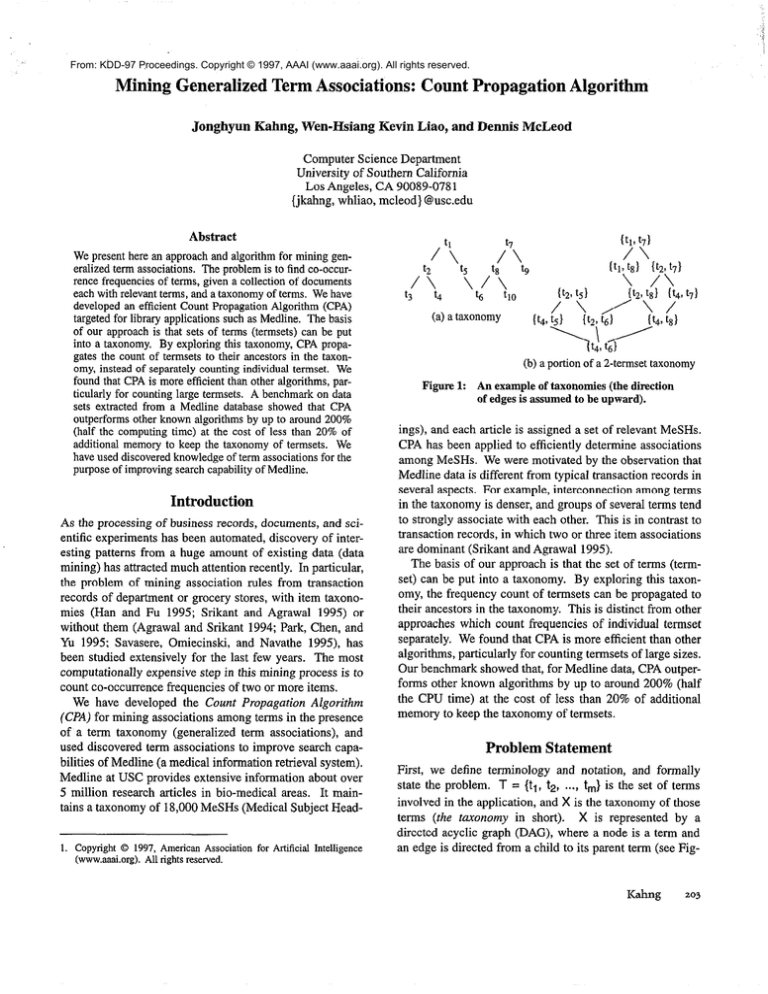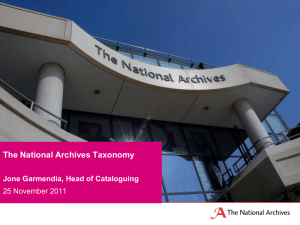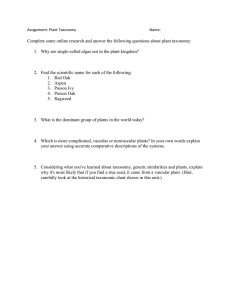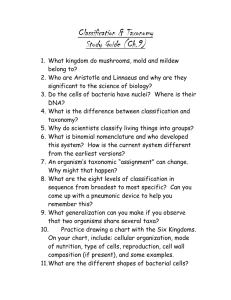
From: KDD-97 Proceedings. Copyright © 1997, AAAI (www.aaai.org). All rights reserved.
Mining Generalized Term Associations: Count Propagation Algorithm
Jonghyun Kahng, Wen-Hsiang Kevin Liao, and Dennis McLeod
Computer Science Department
University of Southern California
Los Angeles, CA 90089-078 1
{jkahng, whliao, mcleod} @usc.edu
Abstract
We presenthere an approachand algorithm for mining generalized term associations. The problem is to find co-occurrence frequenciesof terms, given a collection of documents
each with relevant terms, and a taxonomy of terms. We have
developed an efficient Count PropagationAlgorithm (CPA)
targetedfor library applications such as Medline. The basis
of our approach is that sets of terms (termsets) can be put
into a taxonomy. By exploring this taxonomy, CPA propagates the count of termsets to their ancestorsin the taxonomy, instead of separatelycounting individual termset. We
found that CPA is more efficient than other algorithms, particularly for counting large termsets. A benchmark on data
sets extracted from a Medline database showed that CPA
outperforms other known algorithms by up to around 200%
(half the computing time) at the cost of less than 20% of
additional memory to keep the taxonomy of termsets. We
have used discoveredknowledge of term associationsfor the
purpose of improving searchcapability of Medline.
Introduction
As the processing of business records, documents, and scientific experiments has been automated, discovery of interesting patterns from a huge amount of existing data (data
mining) has attracted much attention recently. In particular,
the problem of mining association rules from transaction
records of department or grocery stores, with item taxonomies (Han and Fu 1995; Srikant and Agrawal 1995) or
without them (Agrawal and Srikant 1994; Park, Chen, and
Yu 1995; Savasere, Omiecinski, and Navathe 1995), has
been studied extensively for the last few years. The most
computationally expensive step in this mining process is to
count co-occurrence frequencies of two or more items.
We have developed the Count Propagation Algorithm
(CPA) for mining associations among terms in the presence
of a term taxonomy (generalized term associations), and
used discovered term associations to improve search capabilities of Medline (a medical information retrieval system).
Medline at USC provides extensive information about over
5 million research articles in bio-medical areas. It maintains a taxonomy of 18,000 MeSHs (Medical Subject Head1. Copyright 0 1997, American Association for Artificial Intelligence
(www.aaai.org). All rights reserved.
it19 t7)
/\
It17 t8)
it29 t7}
tl
(b) a portion of a 2-termsettaxonomy
Figure 1: An example of taxonomies (the direction
of
dmx
1- --~-I
in -II-----slrwmd
--
tn
I- he
I- ~mward\.
-r”---/-
ings), and each article is assigned a set of relevant MeSHs.
CPA has been applied to efficiently determine associations
among MeSHs. We were motivated by the observation that
Medline data is different from typical transaction records in
several aspects. For example, interconnection among terms
in the taxonomy is denser, and groups of several terms tend
to strongly associate with each other. This is in contrast to
transaction records, in which two or three item associations
are dominant (Srikant and Agrawal 1995).
The basis of our approach is that the set of terms (tennset) can be put into a taxonomy. By exploring this taxonomy, the frequency count of termsets can be propagated to
their ancestors in the taxonomy. This is distinct from other
approaches which count frequencies of individual termset
separately. We found that CPA is more efficient than other
algorithms, particularly for counting termsets of large sizes.
Our benchmark showed that, for Medline data, CPA outperforms other known algorithms by up to around 200% (half
the CPU time) at the cost of less than 20% of additional
memory to keep the taxonomy of termsets.
Problem Statement
&St,
,rro
"I"
rl‘
afin~
U"l.l.U
tmn-linnlnn~r
L"llllrl.I"I"~J
nncl
c4l.U
nn+ot;nn
II"uI""II,
owl
CzllU
fm.m"ll.,
I"IIIIi&‘IJ
state the problem. T = {tl, f2, . . . . t,,,} is the set of terms
involved in the application, and X is the taxonomy of those
terms (the tuxonomy in short). X is represented by a
directed acyclic graph (DAG), where a node is a term and
an edge is directed from a child to its parent term (see Fig-
Kahng
203
ure l(a) for an example). A term may have multiple parents, implying that multiple classification schemes are
represented by the taxonomy.
A termset refers to a set of terms, and n-termset is a set of
n terms. A termset s is triviuE if it contains one or more
ancestor/descendant pairs (e.g., {fz, t4, ts}). For the rest of
this paper, a termset will refer to a non-trivial termset,
unless otherwise mentioned. A termset ~1 is an ancestor of
a termset ~2 if ~1 and ~2 have the same number of terms
and any term in ~1 is either a term in s2 or an ancestor of
one or more terms in s2. S1 is a parent of Sp if S1 is an
ancestor of s2 and there does not exist a termset sg such
that ~1 is an ancestor of sg and ~3 is an ancestor of ~2 (e.g.,
parents of (t4, t6) are (t2, t6}, (t4, ts}, and {t4, ts}). Descendants and children of a termset are similarly defined. A
termset taxonomy is represented by a DAG, where a node is
a termset and an edge is directed from a child to its parent
termset. Figure I(b) shows a portion of a 2-termset taxonomy, including all ancestors of {td, fe}.
The database in the application is denoted by 0, and
called a set of term occurrences (or a set of occurrences in
shortj;
each occurrence is a subset 0fT. An occurrence corresponds to the set of items in a department transaction
record, and the set of terms (MeSHs) assigned to an article
in Medline. For a given X, an extended occurrence of an
occurrence o consists of all terms in o and all of their
ancestors.
An occurrence o supports a termset s if and only if every
term in S is either a term in 0 or an ancestor of one or more
terms in 0. For example, o = {td, t6, t, o} supports {tb}, {t6},
{tloh 04, tfjh U4, GoI, {t6, td, U4, t6, Q0h and all antestors of these termsets. The support of a termset is the percentage of occurrences that support it. A termset with a
support over a certain threshold (a minimum support) is
called afrequent termset. It follows from definitions that a
termset s is supported by o if and only if s is a subset of the
extended occurrence of O; and that all ancestors of a frequent termset are also frequent termsets.
With this terminology, the problem of mining generalized term associations is formally defined as:
Given a term taxonomy, a set of occurrences, and a
minimum support, find all frequent termsets.
Count Propagation Algorithm
We now examine the new concepts and mechanism that are
necessary for a count propagation scheme. Given a taxonomy X, the reduced taxonomy X’ is a taxonomy derived
from X such that X’ has the same terms as X, a term in X’
has at most one parent and at most one child, and a term
that has multiple parents or multiple children based on X is
either a root or a leaf in x’. Figure 2(a)-(b) shows an exam-
204
KDD-97
t1
I
t4I
65
I
. t8I t1ot11, t13
t3
(b) a reducedtaxonomy
It17 t41
.
/\
It29 t41
It19 5)
‘Y\
/
It33 t4-b _ It29 t5)
(a) a taxonomy
(c) a portion of a 2-termset taxonomy
Figure 2: An example of taxonomies.
ple of this derivation. In the initial stage of the frequency
counting, x’ will be heavily fragmented because most terms
in X are likely to have either multiple parents or multiple
children. In the later stage, however, if terms that are
unnecessary for further counting are removed from X, the
average height of trees in X’ will increase.
Given X and X’ derived from X, the augmented occurrence 0' of an occurrence o is derived from o as follows.
First, add to 0' all terms in o and all their ancestors based on
X. Then, if more than one term in the same tree of X’ are
present in 0’, keep only the one with the greatest depth and
remove all the others. For example, 0’ = (t3, f7, tg, t10, tl A}
results from o = {tll}, and 0’ = (f3, tg, t,, tg, tjO, $1)
results from 0 = (t5, tll}.
The transformed problem given by X’ and 0’ has an
interesting property:
Theorem The set of frequent termsets F’ computed
from X’ and 0’ includes the set of frequent termsets F
computed from X and 0, and F’ - F consists of termsets that are non-trivial based on X’ but trivial based on
X.
The extended occurrence of o in 0 (based on X) is the same
as that of the corresponding 0’ in 0’ (based on X’) so that o
and 0’ supports the same termsets. The only difference is
that, among those supported termsets, trivial ones based on
X are different from those based on X’: the latter is included
in the former. This is because x’ misses some of ancestor/
descendant relationships present in X. For example, t3 is an
ancestor of t6 in X, but not in X’ so that (t3, t6) is trivial
based on X, but non-trivial based on X’. Therefore, X’ and
0’ will result in the same frequent termsets as X and 0 as
far as termsets that are trivial based on X are excluded.
CPA transforms the problem given by X and 0 into
another problem given by derived x’ and 0’, and computes
frequent termsets for the transformed problem. Extra care
is necessary, of course, for termsets that are trivial based on
X. But, for the moment, let’s focus on the problem given by
VI n,,u
-A ”n~...:+h
,.+L-. L”IIDIILLIIIID.
.-- kn:..+m V’
+nvr\..rr
A ,,A
LulLItn-no+
LG11113cIL
Lcl*“II”A
Wllll _,.
1,” “Lllrjl
mies built from it have some simple and nice properties:
l
A term t in X’ is uniquely identified by an index
defined as cr, d> where r is the root of the DAG that
contains t and d is the depth of t in the DAG (e.g.,
the index of tl, t2, t3 is ctl, O>, ~11, l>, ctl, 2>,
respectively). The index makes it easy to identify
relationships between two terms. For tl with an
index crl, dl> and t2 with an index cr2, dp, tl is
an ancestor (or a descendant) of t2 if and only if rl =
r, and
d;
< t-l, (nr
-L \--
c-i, > &+
- I -
Termset taxonomies built from X’ has a simple structure. As for terms, a termset s in such termset taxonomies can be uniquely identified by an index which
is the set of indices of the terms in S. A termset s
with an index {cut, dl>, . . . . KU,, d,>} is an ancestor of a termset q with an index {cvq, el>, . . . . CV,,
en>} if and only ifs and q are not identical and, for
any i, there exists j such that Ui = Vi and di <= ej.
That is, any ancestor of a termset q can be obtained
by simply replacing one or more terms in g with
their ancestors. Note that this is not true if X’
allowed multiple parents or multiple children
because thus obtained termsets may turn out to be
trivial.
CPA keeps only candidate termsets in termset taxonomies, and use them for top-down count propagation. Suppose that a termset s is a subset of an augmented
occurrence 0’ so that s and its ancestors are supported by 0’.
CPA first checks if the root of the DAG that contains s is
present in the taxonomy. If it is not, no ancestor of s are
l
nrewnt
y'""""'
in
A.. the
..A"
taYnnnmv
C....V'.V"',
~0 &t
~0 f~~fi*h~.r g~~~ntino
ic
0 --
net----
essary. But, if it is present, CPA traverses down the DAG
while counting all ancestors of s on the way. Indices of
termsets are used to identify the root and to determine
whether termsets in the DAG are ancestors of s or not. Figure 2(c) shows a portion of the 2-termset taxonomy constructed from X’ in Figure 2(b). Suppose that the termsets
below the dotted line are not candidate termsets so that they
are not stored in the taxonomy. If an augmented occurrence
0’ contains a termset {t3, 5}, the counting begins at the root
(tq, t4) and propagates
down to 02, f41, 01, k,l, and {b, k,}.
- Coming back to the problem of termsets that are trivial
based on X, but non-trivial based on x’, it is possible to discard them after frequent termsets are computed. This strategy will however waste a lot of computing time and
Therefore, those termsets should rather be
memory.
removed from termset taxonomies before the counting
begins. This operation is simple enough, but it would break
down the count propagation scheme just described, if some
ancestors of a termset s were removed while s remained.
Such a problematic situation would not happen because, if a
termset s in the termset taxonomy is trivial based on X, all
tn-anto
LbLIIIJbLJ
;n
111 tha
11.b l-xAfZ
ULILI
that
LllLII onnt&nr
cI”lllllllli)
a,-~ c4I.J”
alan
t,-irrinl
nn
”E L&L*
I.&1“XUl hcxrwl
“U.JYU “1,
X so that the whole DAG drops out of the termset taxonomy. In other words, if a termset s remains in the termset
taxonomy, so do all of its ancestors.
In summary, CPA partially extends occurrences 0 into
augmented occurrences 0’, and partially relies on count
propagation using termset taxonomies built from the
reduced taxonomy X’. It would be especially efficient when
the average height of trees in X’ is large so that a large portion of counting is covered by propagation. This is likely to
happen when the given taxonomy X is deep and the counting procedure reaches later iterations. (Due to the space
limitation, details of the algorithm will be reported elsewhere.)
Performance Evaluation
We have implemented CPA and evaluated its performance
in comparison with other algorithms. Among the two algorithms, Cumulate and EstMerge, developed by IBM for
mining generalized association rules (Srikant and Agratial
1QWA
“/“,,
the
. . ..-
latter
*....-.
&owed
only
2
rr?qind
nerfnrmnnw.
I -__-_-__ - _.--
improvement over the former. Han and Fu (1995) reported
another algorithm whose strategy is similar to EstMerge.
We therefore chose and implemented Cumulate for comparison with CPA. Our benchmark was run on a Sun SPARCStation 20 running SunOS 4.1.3 with 128 MB of real
memory and 439 MB of virtual memory.
We have compared CPA with Cumulate for data sets
extracted from a Medline database at USC. Each article in
Medline has major and minor MeSHs (Medical Subject
Headings) which are selected from the 18,000 MeSH taxonomy. We picked the major MeSH field, and applied the
algorithms to discover associations among MeSHs.
In all cases that we checked on different sets of research
articles from Medline, CPA showed better performance
than Cumulate, the ratio of the total CPU times varying
between 35% and 75% (Figure 3(a)-(b)). Figure 3(c) shows
the breakdown of the CPU times into each iteration (the nth
iteration computes frequent n-termsets) for a typical case of
our benchmark. As expected, the performance gain of CPA
over Cumulate becomes higher for later iterations. Memory
P A,~ A-- -1.. IL, - ,-..- -.-.-- _.-.__J :-IT: ___-_?,A,
usages or me two algorlrnms dre Lompdreu in r~gurt: J(U)
for the same data set as in Figure 3(c). The figure indicates
that CPA uses less than 20% of additional memory to store
termset taxonomies near the peak use of the memory (iterations five through nine).
Conclusions
An algorithm CPA for mining generalized term associations
was presented, and it was shown that, for Medline data,
Kahng
20s
@-ElCumulate
O0.5
1.0
1.5
2.0
min support (%)
(a) no of occurrences= 20K
150 W Cumulate
. -CPA
23
3 100 B
I+
‘r! 50 2
u
t
0;
-0
CPA performs better than a known algorithm, Cumulate.
Other algorithms for generalized association rules, including Cumulate, have been designed and tested for department transaction records. We found that our data sets from
Medline have characteristics very different from the transaction records. We expect that other library data would
behave more like Medline data than department transaction
records so that other library applications will also benefit
from the count propagation technique of CPA. More investigation is on the way to confirm this conjecture.
We have used discovered term associations to improve
the search mechanism of Medline, within the context of
USC Brain Project (Arbib et al.). In particular, we have
developed a query interface that progressively guides users
to refine queries by providing MeSHs that might be relevant
to their interests. Further, we found that the knowledge of
term associations is very useful for measuring relevance of
documents to a given query.
Acknowledgments
10
15
5
no of occurrences(‘000)
(b) min support = 1%
20
We would like to express our gratitude to Drs. Ramakrishnan Srikant and Rakesh Agrawal for providing their synthetic data for our experiment.
This research has been funded in part by NIMH under
grant no. 5POlMD/DA52194-02,
and in part by the Integrated Media Systems Center, a National Science Foundation Engineering Research Center with additional support
from the Annenberg Center for Communication at the University of Southern California and the California Trade and
Commerce Agency.
References
Agrawal, R., and Srikant, R. 1994. Fast algorithms for mining
0
0
5
iteration
10
15
(c) no of occurrences= 20K, min support = 1%
W Cumulate
association rules. In Proceedings of the 20th International Conference on Very Large Data Bases, pages487-499, Santigo, Chile.
Arbib, M. et al. USC Brain Project. Refer to http://wwhbp.usc.edu/.
Han, J., and Fu,Y. 1995. Discovery of multi-level associationrules
from large databases.In Proceedings of the 21st International
Conference on Very Large Data Bases, pages 420-431, Zurich,
Swizerland.
Park, J. S., Chen, M.-S., and Yu, I? S. 1995. An effective hashbased algorithm for mining association rules. In Proceedings of
the ACM SIGMOD International Conference on Management of
Data, pages 175-186, San Jose, CA.
Savasere,A., Omiecinski, E., and Navathe, S. 1995. An efficient
algorithm for mining associationrules in large databases.In Pro-
0 t-
mnrl:nnr
nfthn*cccA401
3 1-t A,‘
7s4tonmt;.3nnl
rnnforonFo
Inroo ~’ Y--L.
nntn
t,cIGw&r1~*
“J
I~IIIMbIV,IG+I
v”,*JJc,c,‘c’ nw
“II Van,
V”J YY’
Bases, pages432-444, Zurich, Swizerland.
5
iteration
10
15
(d) no of occurrences= ZOK,min support = 1%
Figure 3: A benchmark on Medline data.
206
KDD-97
Srikant, R., and Agrawal, R. 1995. Mining generalizedassociation
rules. In Proceedings of the 21st International Conference on Very
Large Data Bases, pages407-419, Zurich, Swizerland.







